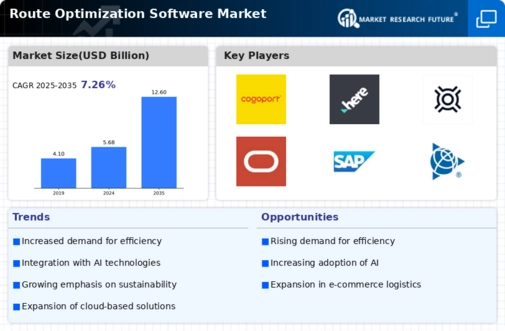Cloud-Based
On-Premise
Hybrid
Transportation and Logistics
Retail
Healthcare
Government
Real-Time Tracking
Traffic Analysis
Multi-Stop Routing
Route Analytics
Mobile Compatibility
Fleet Management
Last-Mile Delivery
Field Service Management
North America
Europe
South America
Asia Pacific
Middle East and Africa
North America Outlook (USD Billion, 2019-2032)
North America Route Optimization Software Market by Deployment Type
Cloud-Based
On-Premise
Hybrid
North America Route Optimization Software Market by End User Type
Transportation and Logistics
Retail
Healthcare
Government
North America Route Optimization Software Market by Features Type
Real-Time Tracking
Traffic Analysis
Multi-Stop Routing
Route Analytics
Mobile Compatibility
North America Route Optimization Software Market by Application Type
Fleet Management
Last-Mile Delivery
Field Service Management
North America Route Optimization Software Market by Regional Type
US
Canada
US Outlook (USD Billion, 2019-2032)
US Route Optimization Software Market by Deployment Type
Cloud-Based
On-Premise
Hybrid
US Route Optimization Software Market by End User Type
Transportation and Logistics
Retail
Healthcare
Government
US Route Optimization Software Market by Features Type
Real-Time Tracking
Traffic Analysis
Multi-Stop Routing
Route Analytics
Mobile Compatibility
US Route Optimization Software Market by Application Type
Fleet Management
Last-Mile Delivery
Field Service Management
CANADA Outlook (USD Billion, 2019-2032)
CANADA Route Optimization Software Market by Deployment Type
Cloud-Based
On-Premise
Hybrid
CANADA Route Optimization Software Market by End User Type
Transportation and Logistics
Retail
Healthcare
Government
CANADA Route Optimization Software Market by Features Type
Real-Time Tracking
Traffic Analysis
Multi-Stop Routing
Route Analytics
Mobile Compatibility
CANADA Route Optimization Software Market by Application Type
Fleet Management
Last-Mile Delivery
Field Service Management
Europe Outlook (USD Billion, 2019-2032)
Europe Route Optimization Software Market by Deployment Type
Cloud-Based
On-Premise
Hybrid
Europe Route Optimization Software Market by End User Type
Transportation and Logistics
Retail
Healthcare
Government
Europe Route Optimization Software Market by Features Type
Real-Time Tracking
Traffic Analysis
Multi-Stop Routing
Route Analytics
Mobile Compatibility
Europe Route Optimization Software Market by Application Type
Fleet Management
Last-Mile Delivery
Field Service Management
Europe Route Optimization Software Market by Regional Type
Germany
UK
France
Russia
Italy
Spain
Rest of Europe
GERMANY Outlook (USD Billion, 2019-2032)
GERMANY Route Optimization Software Market by Deployment Type
Cloud-Based
On-Premise
Hybrid
GERMANY Route Optimization Software Market by End User Type
Transportation and Logistics
Retail
Healthcare
Government
GERMANY Route Optimization Software Market by Features Type
Real-Time Tracking
Traffic Analysis
Multi-Stop Routing
Route Analytics
Mobile Compatibility
GERMANY Route Optimization Software Market by Application Type
Fleet Management
Last-Mile Delivery
Field Service Management
UK Outlook (USD Billion, 2019-2032)
UK Route Optimization Software Market by Deployment Type
Cloud-Based
On-Premise
Hybrid
UK Route Optimization Software Market by End User Type
Transportation and Logistics
Retail
Healthcare
Government
UK Route Optimization Software Market by Features Type
Real-Time Tracking
Traffic Analysis
Multi-Stop Routing
Route Analytics
Mobile Compatibility
UK Route Optimization Software Market by Application Type
Fleet Management
Last-Mile Delivery
Field Service Management
FRANCE Outlook (USD Billion, 2019-2032)
FRANCE Route Optimization Software Market by Deployment Type
Cloud-Based
On-Premise
Hybrid
FRANCE Route Optimization Software Market by End User Type
Transportation and Logistics
Retail
Healthcare
Government
FRANCE Route Optimization Software Market by Features Type
Real-Time Tracking
Traffic Analysis
Multi-Stop Routing
Route Analytics
Mobile Compatibility
FRANCE Route Optimization Software Market by Application Type
Fleet Management
Last-Mile Delivery
Field Service Management
RUSSIA Outlook (USD Billion, 2019-2032)
RUSSIA Route Optimization Software Market by Deployment Type
Cloud-Based
On-Premise
Hybrid
RUSSIA Route Optimization Software Market by End User Type
Transportation and Logistics
Retail
Healthcare
Government
RUSSIA Route Optimization Software Market by Features Type
Real-Time Tracking
Traffic Analysis
Multi-Stop Routing
Route Analytics
Mobile Compatibility
RUSSIA Route Optimization Software Market by Application Type
Fleet Management
Last-Mile Delivery
Field Service Management
ITALY Outlook (USD Billion, 2019-2032)
ITALY Route Optimization Software Market by Deployment Type
Cloud-Based
On-Premise
Hybrid
ITALY Route Optimization Software Market by End User Type
Transportation and Logistics
Retail
Healthcare
Government
ITALY Route Optimization Software Market by Features Type
Real-Time Tracking
Traffic Analysis
Multi-Stop Routing
Route Analytics
Mobile Compatibility
ITALY Route Optimization Software Market by Application Type
Fleet Management
Last-Mile Delivery
Field Service Management
SPAIN Outlook (USD Billion, 2019-2032)
SPAIN Route Optimization Software Market by Deployment Type
Cloud-Based
On-Premise
Hybrid
SPAIN Route Optimization Software Market by End User Type
Transportation and Logistics
Retail
Healthcare
Government
SPAIN Route Optimization Software Market by Features Type
Real-Time Tracking
Traffic Analysis
Multi-Stop Routing
Route Analytics
Mobile Compatibility
SPAIN Route Optimization Software Market by Application Type
Fleet Management
Last-Mile Delivery
Field Service Management
REST OF EUROPE Outlook (USD Billion, 2019-2032)
REST OF EUROPE Route Optimization Software Market by Deployment Type
Cloud-Based
On-Premise
Hybrid
REST OF EUROPE Route Optimization Software Market by End User Type
Transportation and Logistics
Retail
Healthcare
Government
REST OF EUROPE Route Optimization Software Market by Features Type
Real-Time Tracking
Traffic Analysis
Multi-Stop Routing
Route Analytics
Mobile Compatibility
REST OF EUROPE Route Optimization Software Market by Application Type
Fleet Management
Last-Mile Delivery
Field Service Management
APAC Outlook (USD Billion, 2019-2032)
APAC Route Optimization Software Market by Deployment Type
Cloud-Based
On-Premise
Hybrid
APAC Route Optimization Software Market by End User Type
Transportation and Logistics
Retail
Healthcare
Government
APAC Route Optimization Software Market by Features Type
Real-Time Tracking
Traffic Analysis
Multi-Stop Routing
Route Analytics
Mobile Compatibility
APAC Route Optimization Software Market by Application Type
Fleet Management
Last-Mile Delivery
Field Service Management
APAC Route Optimization Software Market by Regional Type
China
India
Japan
South Korea
Malaysia
Thailand
Indonesia
Rest of APAC
CHINA Outlook (USD Billion, 2019-2032)
CHINA Route Optimization Software Market by Deployment Type
Cloud-Based
On-Premise
Hybrid
CHINA Route Optimization Software Market by End User Type
Transportation and Logistics
Retail
Healthcare
Government
CHINA Route Optimization Software Market by Features Type
Real-Time Tracking
Traffic Analysis
Multi-Stop Routing
Route Analytics
Mobile Compatibility
CHINA Route Optimization Software Market by Application Type
Fleet Management
Last-Mile Delivery
Field Service Management
INDIA Outlook (USD Billion, 2019-2032)
INDIA Route Optimization Software Market by Deployment Type
Cloud-Based
On-Premise
Hybrid
INDIA Route Optimization Software Market by End User Type
Transportation and Logistics
Retail
Healthcare
Government
INDIA Route Optimization Software Market by Features Type
Real-Time Tracking
Traffic Analysis
Multi-Stop Routing
Route Analytics
Mobile Compatibility
INDIA Route Optimization Software Market by Application Type
Fleet Management
Last-Mile Delivery
Field Service Management
JAPAN Outlook (USD Billion, 2019-2032)
JAPAN Route Optimization Software Market by Deployment Type
Cloud-Based
On-Premise
Hybrid
JAPAN Route Optimization Software Market by End User Type
Transportation and Logistics
Retail
Healthcare
Government
JAPAN Route Optimization Software Market by Features Type
Real-Time Tracking
Traffic Analysis
Multi-Stop Routing
Route Analytics
Mobile Compatibility
JAPAN Route Optimization Software Market by Application Type
Fleet Management
Last-Mile Delivery
Field Service Management
SOUTH KOREA Outlook (USD Billion, 2019-2032)
SOUTH KOREA Route Optimization Software Market by Deployment Type
Cloud-Based
On-Premise
Hybrid
SOUTH KOREA Route Optimization Software Market by End User Type
Transportation and Logistics
Retail
Healthcare
Government
SOUTH KOREA Route Optimization Software Market by Features Type
Real-Time Tracking
Traffic Analysis
Multi-Stop Routing
Route Analytics
Mobile Compatibility
SOUTH KOREA Route Optimization Software Market by Application Type
Fleet Management
Last-Mile Delivery
Field Service Management
MALAYSIA Outlook (USD Billion, 2019-2032)
MALAYSIA Route Optimization Software Market by Deployment Type
Cloud-Based
On-Premise
Hybrid
MALAYSIA Route Optimization Software Market by End User Type
Transportation and Logistics
Retail
Healthcare
Government
MALAYSIA Route Optimization Software Market by Features Type
Real-Time Tracking
Traffic Analysis
Multi-Stop Routing
Route Analytics
Mobile Compatibility
MALAYSIA Route Optimization Software Market by Application Type
Fleet Management
Last-Mile Delivery
Field Service Management
THAILAND Outlook (USD Billion, 2019-2032)
THAILAND Route Optimization Software Market by Deployment Type
Cloud-Based
On-Premise
Hybrid
THAILAND Route Optimization Software Market by End User Type
Transportation and Logistics
Retail
Healthcare
Government
THAILAND Route Optimization Software Market by Features Type
Real-Time Tracking
Traffic Analysis
Multi-Stop Routing
Route Analytics
Mobile Compatibility
THAILAND Route Optimization Software Market by Application Type
Fleet Management
Last-Mile Delivery
Field Service Management
INDONESIA Outlook (USD Billion, 2019-2032)
INDONESIA Route Optimization Software Market by Deployment Type
Cloud-Based
On-Premise
Hybrid
INDONESIA Route Optimization Software Market by End User Type
Transportation and Logistics
Retail
Healthcare
Government
INDONESIA Route Optimization Software Market by Features Type
Real-Time Tracking
Traffic Analysis
Multi-Stop Routing
Route Analytics
Mobile Compatibility
INDONESIA Route Optimization Software Market by Application Type
Fleet Management
Last-Mile Delivery
Field Service Management
REST OF APAC Outlook (USD Billion, 2019-2032)
REST OF APAC Route Optimization Software Market by Deployment Type
Cloud-Based
On-Premise
Hybrid
REST OF APAC Route Optimization Software Market by End User Type
Transportation and Logistics
Retail
Healthcare
Government
REST OF APAC Route Optimization Software Market by Features Type
Real-Time Tracking
Traffic Analysis
Multi-Stop Routing
Route Analytics
Mobile Compatibility
REST OF APAC Route Optimization Software Market by Application Type
Fleet Management
Last-Mile Delivery
Field Service Management
South America Outlook (USD Billion, 2019-2032)
South America Route Optimization Software Market by Deployment Type
Cloud-Based
On-Premise
Hybrid
South America Route Optimization Software Market by End User Type
Transportation and Logistics
Retail
Healthcare
Government
South America Route Optimization Software Market by Features Type
Real-Time Tracking
Traffic Analysis
Multi-Stop Routing
Route Analytics
Mobile Compatibility
South America Route Optimization Software Market by Application Type
Fleet Management
Last-Mile Delivery
Field Service Management
South America Route Optimization Software Market by Regional Type
Brazil
Mexico
Argentina
Rest of South America
BRAZIL Outlook (USD Billion, 2019-2032)
BRAZIL Route Optimization Software Market by Deployment Type
Cloud-Based
On-Premise
Hybrid
BRAZIL Route Optimization Software Market by End User Type
Transportation and Logistics
Retail
Healthcare
Government
BRAZIL Route Optimization Software Market by Features Type
Real-Time Tracking
Traffic Analysis
Multi-Stop Routing
Route Analytics
Mobile Compatibility
BRAZIL Route Optimization Software Market by Application Type
Fleet Management
Last-Mile Delivery
Field Service Management
MEXICO Outlook (USD Billion, 2019-2032)
MEXICO Route Optimization Software Market by Deployment Type
Cloud-Based
On-Premise
Hybrid
MEXICO Route Optimization Software Market by End User Type
Transportation and Logistics
Retail
Healthcare
Government
MEXICO Route Optimization Software Market by Features Type
Real-Time Tracking
Traffic Analysis
Multi-Stop Routing
Route Analytics
Mobile Compatibility
MEXICO Route Optimization Software Market by Application Type
Fleet Management
Last-Mile Delivery
Field Service Management
ARGENTINA Outlook (USD Billion, 2019-2032)
ARGENTINA Route Optimization Software Market by Deployment Type
Cloud-Based
On-Premise
Hybrid
ARGENTINA Route Optimization Software Market by End User Type
Transportation and Logistics
Retail
Healthcare
Government
ARGENTINA Route Optimization Software Market by Features Type
Real-Time Tracking
Traffic Analysis
Multi-Stop Routing
Route Analytics
Mobile Compatibility
ARGENTINA Route Optimization Software Market by Application Type
Fleet Management
Last-Mile Delivery
Field Service Management
REST OF SOUTH AMERICA Outlook (USD Billion, 2019-2032)
REST OF SOUTH AMERICA Route Optimization Software Market by Deployment Type
Cloud-Based
On-Premise
Hybrid
REST OF SOUTH AMERICA Route Optimization Software Market by End User Type
Transportation and Logistics
Retail
Healthcare
Government
REST OF SOUTH AMERICA Route Optimization Software Market by Features Type
Real-Time Tracking
Traffic Analysis
Multi-Stop Routing
Route Analytics
Mobile Compatibility
REST OF SOUTH AMERICA Route Optimization Software Market by Application Type
Fleet Management
Last-Mile Delivery
Field Service Management
MEA Outlook (USD Billion, 2019-2032)
MEA Route Optimization Software Market by Deployment Type
Cloud-Based
On-Premise
Hybrid
MEA Route Optimization Software Market by End User Type
Transportation and Logistics
Retail
Healthcare
Government
MEA Route Optimization Software Market by Features Type
Real-Time Tracking
Traffic Analysis
Multi-Stop Routing
Route Analytics
Mobile Compatibility
MEA Route Optimization Software Market by Application Type
Fleet Management
Last-Mile Delivery
Field Service Management
MEA Route Optimization Software Market by Regional Type
GCC Countries
South Africa
Rest of MEA
GCC COUNTRIES Outlook (USD Billion, 2019-2032)
GCC COUNTRIES Route Optimization Software Market by Deployment Type
Cloud-Based
On-Premise
Hybrid
GCC COUNTRIES Route Optimization Software Market by End User Type
Transportation and Logistics
Retail
Healthcare
Government
GCC COUNTRIES Route Optimization Software Market by Features Type
Real-Time Tracking
Traffic Analysis
Multi-Stop Routing
Route Analytics
Mobile Compatibility
GCC COUNTRIES Route Optimization Software Market by Application Type
Fleet Management
Last-Mile Delivery
Field Service Management
SOUTH AFRICA Outlook (USD Billion, 2019-2032)
SOUTH AFRICA Route Optimization Software Market by Deployment Type
Cloud-Based
On-Premise
Hybrid
SOUTH AFRICA Route Optimization Software Market by End User Type
Transportation and Logistics
Retail
Healthcare
Government
SOUTH AFRICA Route Optimization Software Market by Features Type
Real-Time Tracking
Traffic Analysis
Multi-Stop Routing
Route Analytics
Mobile Compatibility
SOUTH AFRICA Route Optimization Software Market by Application Type
Fleet Management
Last-Mile Delivery
Field Service Management
REST OF MEA Outlook (USD Billion, 2019-2032)
REST OF MEA Route Optimization Software Market by Deployment Type
Cloud-Based
On-Premise
Hybrid
REST OF MEA Route Optimization Software Market by End User Type
Transportation and Logistics
Retail
Healthcare
Government
REST OF MEA Route Optimization Software Market by Features Type
Real-Time Tracking
Traffic Analysis
Multi-Stop Routing
Route Analytics
Mobile Compatibility
REST OF MEA Route Optimization Software Market by Application Type
Fleet Management
Last-Mile Delivery
Field Service Management

















Leave a Comment